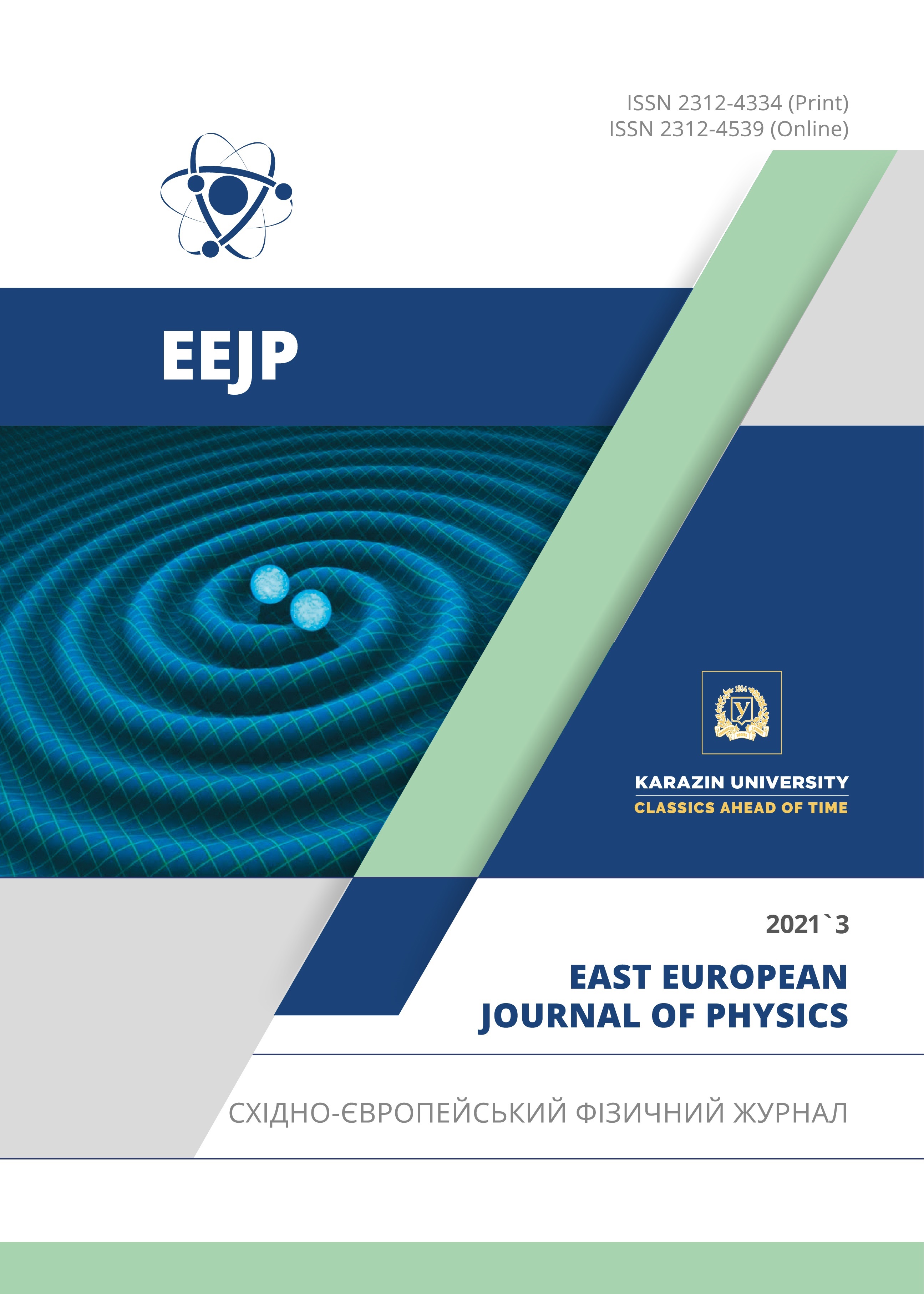Structure and Physical Properties of Cast and Splat-Quenched CoCr0.8Cu0.64FeNi High Entropy Alloy
Abstract
The article investigates the structure and physical properties of the multicomponent high-entropy alloy CoCr0.8Cu0.64FeNi in the cast and quenched state. The composition of the alloy under study is analyzed using the criteria available in the literature for predicting the phase composition of high-entropy alloys. These parameters are based on calculations of the entropy and enthalpy of mixing and also include the concentration of valence electrons, the thermodynamic parameter Ω, which takes into account the melting point, entropy of mixing, and enthalpy of mixing. Another important parameter is the difference in atomic radii between the alloy components δ. Cast samples of the CoCr0.8Cu0.64FeNi alloy of nominal composition were prepared on a Tamman high-temperature electric furnace in an argon flow using a copper mold. The weight loss during the manufacture of ingots did not exceed 1%, and the average cooling rate was ~ 102K/s. Thereafter, the cast ingot was remelted, and films were obtained from the melt. The splat quenching technique used in this work consisted of the rapid cooling of melt droplets when they collide with the inner surface of a rapidly rotating (~ 8000 rpm) hollow copper cylinder. The cooling rate, estimated from the film thickness, was ~ 106 K / s. X-ray structural analysis was performed on a DRON-2.0 diffractometer with monochromatic Cu Kα radiation. Diffraction patterns were processed using the QualX2 program. The magnetic properties of the samples were measured using a vibrating sample magnetometer at room temperature. The microhardness was measured on a PMT-3 device at a load of 50 g. In accordance with theoretical predictions confirmed by the results of X-ray diffraction studies, the structure of the alloy, both in the cast and in the quenched state, is a simple solid solution of the FCC type. The lattice parameters in the cast and liquid-quenched states are 0.3593 nm and 0.3589 nm, respectively. Measurements of the magnetic properties showed that the CoCr0.8Cu0.64FeNi alloy can be classified as soft magnetic materials. In this case, quenching from a liquid state increases the coercivity. On quenched samples, increased microhardness values were also obtained. This can be explained by internal stresses arising during hardening.
Downloads
References
B.S. Murty, J.W. Yeh, S. Ranganathan, and P.P. Bhattacharjee, High-Entropy Alloys 2nd Edition (Elsevier, 2019).
T.S. Srivatsan and M. Gupta, editors, High Entropy Alloys. Innovations, Advances, and Applications (CRC Press, Boca Raton, 2020).
D.B. Miracle and O.N. Senkov, Acta Mater. 122, 448 (2017). https://doi.org/10.1016/j.actamat.2016.08.081.
Y. Dong, Z. Yao, X. Huang, F. Du, C. Li, A. Chen, F. Wu, Y. Cheng, and Z. Zhang, J. Alloys Compd. 823, 153886 (2020). https://doi.org/10.1016/j.jallcom.2020.153886.
Y.K. Kim, S. Yang, and K.A. Lee, Sci. Rep. 10, 1 (2020). https://doi.org/10.1038/s41598-020-65073-2.
C. Gadelmeier, S. Haas, T. Lienig, A. Manzoni, M. Feuerbacher, and U. Glatzel, Metals (Basel). 10, 1412 (2020). https://doi.org/10.3390/met10111412.
L. Sang and Y. Xu, J. Non. Cryst. Solids 530, 119854 (2020). https://doi.org/10.1016/j.jnoncrysol.2019.119854.
I.S.Miroshnichenko, Закалка из жидкого состояния [QuenchingFromTheLiquidState], (Metallurgy, Moscow, 1982). (in Russian) .
V.F. Bashev, S.I. Ryabtsev, O.I. Kushnerov, N.A. Kutseva, and S.N. Antropov, East Eur. J. Phys. (3), 81 (2020). https://doi.org/10.26565/2312-4334-2020-3-10.
E. Zhou, D. Qiao, Y. Yang, D. Xu, Y. Lu, J. Wang, J.A. Smith, H. Li, H. Zhao, P.K. Liaw, and F. Wang, J. Mater. Sci. Technol. 46, 201 (2020). https://doi.org/10.1016/j.jmst.2020.01.039.
C. Xiang, E.-H. Han, Z.M. Zhang, H.M. Fu, J.Q. Wang, H.F. Zhang, and G.D. Hu, Intermetallics 104, 143 (2019). https://doi.org/10.1016/j.intermet.2018.11.001.
D. Patel, M.D. Richardson, B. Jim, S. Akhmadaliev, R. Goodall, and A.S. Gandy, J. Nucl. Mater. 531, 152005 (2020). https://doi.org/10.1016/j.jnucmat.2020.152005.
Y.H. Chen, W.S. Chuang, J.C. Huang, X. Wang, H.S. Chou, Y.J. Lai, and P.H. Lin, Appl. Surf. Sci. 508, 145307 (2020). https://doi.org/10.1016/j.apsusc.2020.145307.
G. Perumal, H.S. Grewal, M. Pole, L.V.K. Reddy, S. Mukherjee, H. Singh, G. Manivasagam, and H.S. Arora, ACS Appl. Bio Mater. 3, 1233 (2020). https://doi.org/10.1021/acsabm.9b01127.
G.S. Firstov, T.A. Kosorukova, Y.N. Koval, and V.V. Odnosum, Mater. Today Proc. 2, S499 (2015). https://doi.org/10.1016/j.matpr.2015.07.335.
Y. Li, S. Wang, X. Wang, M. Yin, and W. Zhang, J. Mater. Sci. Technol. 43, 32 (2020). https://doi.org/10.1016/j.jmst.2020.01.020.
J. Lu, Y. Chen, H. Zhang, N. Ni, L. Li, L. He, R. Mu, X. Zhao, and F. Guo, Corros. Sci. 166, 108426 (2020). https://doi.org/10.1016/j.corsci.2019.108426.
F. Körmann, D. Ma, D.D. Belyea, M.S. Lucas, C.W. Miller, B. Grabowski, and M.H.F. Sluiter, Appl. Phys. Lett. 107, 142404 (2015). https://doi.org/10.1063/1.4932571.
S. V. Akimov, V.M. Duda, E.F. Dudnik, A.I. Kushnerev, and A.N. Tomchakov, Phys. Solid State 48, 1073 (2006). https://doi.org/10.1134/S1063783406060175.
E.F. Dudnik, V.M. Duda, and A.I. Kushnerov, Phys. Solid State 43, 2280 (2001). https://doi.org/10.1134/1.1427957.
V.F. Bashev, and O.I. Kushnerov, Phys. Met. Metallogr. 118, 39 (2017). https://doi.org/10.1134/S0031918X16100033.
A. Altomare, N. Corriero, C. Cuocci, A. Falcicchio, A. Moliterni, and R. Rizzi, Powder Diffr. 32, S129 (2017). https://doi.org/10.1017/S0885715617000240.
S. Yang, J. Lu, F. Xing, L. Zhang, and Y. Zhong, Acta Mater. 192, 11 (2020). https://doi.org/10.1016/j.actamat.2020.03.039.
A. Takeuchi and A. Inoue, Mater. Trans. 46, 2817 (2005). https://doi.org/10.2320/matertrans.46.2817.
A.N. Gulivets, V.A. Zabludovsky, E.P. Shtapenko, A.I. Kushnerev, M.P. Dergachov, and A.S. Baskevich, Trans. IMF 80, 154 (2002). https://doi.org/10.1080/00202967.2002.11871457.
Authors who publish with this journal agree to the following terms:
- Authors retain copyright and grant the journal right of first publication with the work simultaneously licensed under a Creative Commons Attribution License that allows others to share the work with an acknowledgment of the work's authorship and initial publication in this journal.
- Authors are able to enter into separate, additional contractual arrangements for the non-exclusive distribution of the journal's published version of the work (e.g., post it to an institutional repository or publish it in a book), with an acknowledgment of its initial publication in this journal.
- Authors are permitted and encouraged to post their work online (e.g., in institutional repositories or on their website) prior to and during the submission process, as it can lead to productive exchanges, as well as earlier and greater citation of published work (See The Effect of Open Access).








